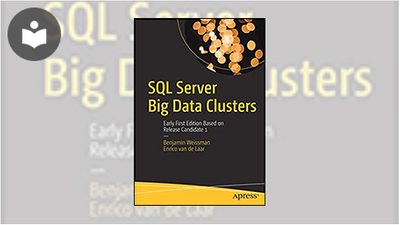SQL Server Big Data Clusters: Early First Edition Based on Release Candidate 1
- 2h 32m
- Benjamin Weissman, Enrico van de Laar
- Apress
- 2019
Get a head-start on learning one of SQL Server 2019’s latest and most impactful features—Big Data Clusters—that combines large volumes of non-relational data for analysis along with data stored relationally inside a SQL Server database. This book provides a first look at Big Data Clusters based upon SQL Server 2019 Release Candidate 1. Start now and get a jump on your competition in learning this important new feature.
Big Data Clusters is a feature set covering data virtualization, distributed computing, and relational databases and provides a complete AI platform across the entire cluster environment. This book shows you how to deploy, manage, and use Big Data Clusters. For example, you will learn how to combine data stored on the HDFS file system together with data stored inside the SQL Server instances that make up the Big Data Cluster.
Filled with clear examples and use cases, this book provides everything necessary to get started working with Big Data Clusters in SQL Server 2019 using Release Candidate 1. You will learn about the architectural foundations that are made up from Kubernetes, Spark, HDFS, and SQL Server on Linux. You then are shown how to configure and deploy Big Data Clusters in on-premises environments or in the cloud. Next, you are taught about querying. You will learn to write queries in Transact-SQL—taking advantage of skills you have honed for years—and with those queries you will be able to examine and analyze data from a wide variety of sources such as Apache Spark.
Through the theoretical foundation provided in this book and easy-to-follow example scripts and notebooks, you will be ready to use and unveil the full potential of SQL Server 2019: combining different types of data spread across widely disparate sources into a single view that is useful for business intelligence and machine learning analysis.
What You Will Learn
- Install, manage, and troubleshoot Big Data Clusters in cloud or on-premise environments
- Analyze large volumes of data directly from SQL Server and/or Apache Spark
- Manage data stored in HDFS from SQL Server as if it were relational data
- Implement advanced analytics solutions through machine learning and AI
- Expose different data sources as a single logical source using data virtualization
Who This Book Is For
For data engineers, data scientists, data architects, and database administrators who want to employ data virtualization and big data analytics in their environment
About the Authors
Ben Weissman is the owner and founder of Solisyon, a consulting firm based in Germany and focused on business intelligence, business analytics, and data warehousing as well as forecasting and budgeting. He is a Microsoft Data Platform MVP, the first German BimlHero, and has been working with SQL Server since SQL Server 6.5. If he’s not currently working with data, Ben is probably traveling and exploring the world, running, or enjoying delicious food. You can find Ben on Twitter at @bweissman.
Enrico van de Laar has been working with data in various formats and sizes for over 15 years. He is a data and advanced analytics consultant at Dataheroes where he helps organizations get the most out of their data. Enrico has been a Microsoft Data Platform MVP since 2014 and a frequent speaker at various data related events all over the world. He writes about a wide variety of Microsoft data-related technologies on his blog at enricovandelaar.com. You can reach Enrico on Twitter at @evdlaar.
In this Book
-
What are Big Data Clusters?
-
Big Data Cluster Architecture
-
Installation, Deployment, and Management of Big Data Clusters
-
Loading Data into Big Data Clusters
-
Querying Big Data Clusters Through T-SQL
-
Working with Spark in Big Data Clusters
-
Machine Learning on Big Data Clusters
-
Create and Consume Big Data Cluster Apps



